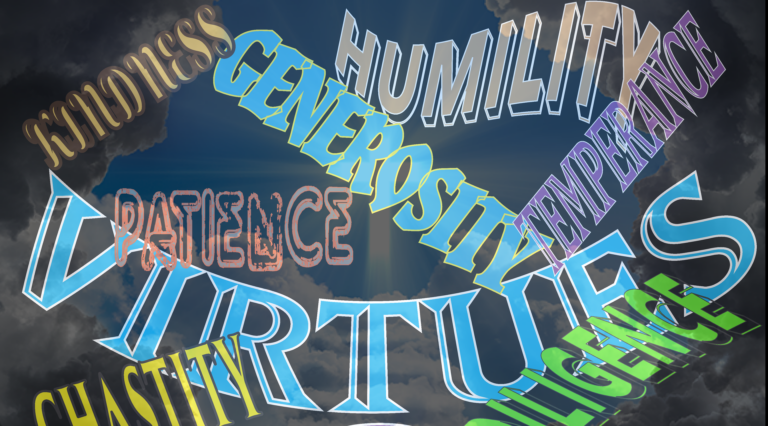How to identify the Seven Deadly Sins in a modern technological world?

Let us consider how the Seven Deadly Sins manifest themselves in our modern age. The Catholic Church, in her wisdom, has long taught that these vices – pride, greed, lust, envy, gluttony, wrath and sloth – represent fundamental human weaknesses that lead us away from God.
What makes the Seven Deadly sins particularly concerning today?
The digital age has created unprecedented opportunities for vice to flourish. Social media platforms feed our pride through carefully curated personas. The endless pursuit of wealth, seen in the stark reality that the richest 10% now earn ten times more than the poor, reveals how greed has evolved beyond mere avarice.
The Holy Church, ever attentive to the signs of the times, acknowledges these new manifestations. Through her teaching authority, she identifies modern expressions of sin – excessive wealth accumulation that deprives the poor, willful damage to God’s creation through environmental destruction, and the manipulation of human life through genetic engineering.
These ancient vices now wear modern garments. The sin of gluttony manifests not only in the 23% obesity rate but in our insatiable consumption of digital content. Wrath finds new expression through online discord and division. Pride and envy flourish in the endless cycle of social media comparison.
I shall guide you through each of these deadly sins, examining how they corrupt souls in our technological age. We must understand these modern manifestations to guard against them and grow in holiness. As Catholics, we are called to recognize sin in all its forms, whether ancient or modern, and through God’s grace, overcome them.
How the Seven Deadly Sins Developed through Church History?
The Holy Church’s understanding of the Seven Deadly Sins traces its origins to the fourth century Desert Fathers. Let us consider how the Venerable Evagrius Ponticus first documented what he termed the “eight evil thoughts”. These original transgressions encompassed gluttony, lust, avarice, anger, sloth, sadness, vainglory, and pride.
A) The Early Church Fathers’ Understanding
The deposit of faith regarding these sins developed through Evagrius’ devoted student, John Cassian, who brought these spiritual concepts to the Western Church. This shows how the Holy Spirit guided the Church’s understanding through her faithful servants. Subsequently, Pope Gregory I, guided by divine wisdom, restructured this framework in the sixth century, removing sloth while adding envy. Moreover, Gregory positioned pride as the root of all other vices, establishing what we now know as the Seven Deadly Sins.
B) The Church’s Growing Wisdom
To understand how this would take place is to draw upon the great Doctor of the Church, St. Thomas Aquinas, who in his masterwork Summa Theologica brought significant clarity by reintroducing sloth and removing sadness. Throughout the medieval period, these sins became deeply embedded in Catholic culture, appearing in sacred art, literature, and Church teachings. This influence continues even into modern entertainment.
What is the eternal relevance of the Seven Deadly Sins?
This is problematic for many modern thinkers who attempt to redefine these sins as mere social constructs – suggesting that greed drives economy, wrath fuels politics, and envy creates motivation. Yet as Catholics, we understand these sins represent fundamental disorders in the human soul that lead us away from God.
The Seven Deadly Sins – pride, greed, wrath, envy, lust, gluttony, and sloth – remain eternally relevant precisely because they speak to the unchanging nature of human weakness. I highly recommend studying these sins not as mere historical concepts, but as spiritual dangers that require our constant vigilance and God’s saving grace to overcome.
Let us now consider how these ancient vices manifest in our modern digital age, where new forms of temptation challenge the faithful.
How do the Seven Deadly Sins manifest in our Modern Digital Age?
1) Pride in the Digital Age: A Modern Challenge to Humility
What does pride look like in our technological era? The sin of pride, which the Church has long identified as the root of all vices, has found new expression through social media platforms. Research reveals a troubling 30% increase in narcissistic personality traits between the late 1970s and mid-2000s, showing how digital platforms feed our inclination toward self-glorification.
- The Corruption of Self-Image Through Instagram
The platform Instagram presents a particular spiritual danger to the faithful. Studies show that souls who spend more than three hours daily on this platform experience significant damage to their self-worth. (Ref: https://pmc.ncbi.nlm.nih.gov/articles/PMC10131713/) This manifests in concerning ways:
- Immediate increases in anxiety when viewing appearance-focused content.
- One-third of women altering their photos before posting, denying God’s creation.
- Direct harm to body image from exposure to retouched selfies.
(Ref: https://www.apa.org/monitor/2022/03/feature-minimize-instagram-effects)
- The Pursuit of Earthly Glory
Much is unknown about the long-term spiritual effects of pursuing viral fame, yet research indicates these platforms reward self-centered behaviors, creating what experts term “acquired situational narcissism”. Those struggling with narcissistic tendencies post more frequently, especially on visual platforms.
This is problematic for many souls, as social media fame triggers addictive responses in the brain. The constant pursuit of digital validation creates what experts describe as a “threat of invisibility”. Moreover, the algorithms driving these platforms force users into endless competition for attention.
Corporate Exploitation of Human Weakness
To understand how this would take place is to examine how companies exploit our inclination toward pride. They create artificial connections through carefully crafted personas. Some even employ artificial influencers like the Instagram personality, further blurring the line between authentic human interaction and manipulation.
The attention economy has transformed our natural desire for belonging into a profitable business model. These platforms deliberately design their systems to maximize engagement, often at the cost of spiritual well-being.
I highly recommend examining our use of social media through the lens of Catholic teaching. As the Church Fathers teach us, pride manifests whenever we place our own glory above God’s. In our digital age, the metrics of likes, shares, and followers have become modern instruments of vanity, leading souls away from true humility and toward a dangerous dependence on human validation.
2) Greed in the Digital Age: The New Face of Avarice
What does the sin of greed look like in our modern world?
The Church Fathers could not have foreseen how avarice would manifest through data and digital power. Yet today, we witness Big Tech companies embodying this ancient vice through unprecedented control over information and markets.
- The Sin of Digital Hoarding
According to recent studies, this modern manifestation of greed appears most clearly in our compulsive accumulation of digital possessions. Consider this: 49% of university students now struggle with organizing their digital files. This attachment to virtual wealth stems from several spiritual weaknesses:
- The fear of losing what we falsely believe we need.
- Unhealthy emotional bonds to digital possessions.
- The burden of excessive information.
- Anxiety over managing virtual wealth.
Much is unknown about the spiritual cost of such behavior, this reveals how digital greed harms our souls.
- The Rise of Information Monopolies
Let us consider how the largest technology companies have positioned themselves as modern-day money changers in the temple of information. Through more than 1,000 acquisitions over the past decade, these corporations have created what the Church would recognize as structures of sin.
This is problematic for many faithful, as we witness Google controlling 70% of search advertising. As Saint Augustine teaches us about greed’s corrupting influence, we see Amazon wielding such power that smaller businesses must submit to exploitation to survive.
- Personal Data: The New Currency of Greed
To understand how this would take place is to examine how personal information has become a tradeable commodity. The tech giants have created what experts term “data monopolies”, exercising control not unlike the wealthy merchants whom Our Lord drove from the temple.
The extent of this greed becomes clear in Google’s repeated privacy policy changes, most recently in 2023, allowing ever-greater harvesting of personal information. This represents not merely accumulation but a fundamental disorder in how power is concentrated in our digital age.
Reflect on how this “Digital Feudalism” affects our spiritual lives. As Catholics, we must recognize how these seemingly free services create bonds of dependency that compromise not only our privacy but potentially our very souls.
The Holy Church teaches us that greed corrupts both the individual and society. In our digital age, this ancient truth finds new relevance as we witness the transformation of avarice from physical wealth to data and power.
3) The Sin of Sloth in Our Technological Age
The sin of sloth, which the Church Fathers warned against as spiritual laziness, has taken new forms through automation and artificial intelligence. Studies reveal a troubling “automation paradox” – the more we rely on AI assistants, the more our God-given abilities decay.
- The False Promise of Digital Ease
Saint Thomas Aquinas teaches that sloth represents a spiritual torpor (decreased physiological activity) that keeps us from pursuing what is good. This wisdom finds new relevance as research shows AI tools create dangerous illusions of understanding. The faithful must recognize three concerning developments:
73% of organizations now embrace automation technologies
- Professional skills deteriorate through excessive reliance on machines.
- God-given productivity decreases by 40% through technology-enabled multitasking.
- The Spiritual Cost of AI Dependence
Much is unknown about the long-term effects of AI on the human soul, yet studies demonstrate how automation weakens our critical thinking and decision-making abilities. This occurs through two mechanisms:
- AI assumes control of higher cognitive functions.
- Human skills atrophy through lack of exercise.
This is problematic for many educators, as AI dependency now hinders students’ development of God-given reasoning abilities. Regular reliance on AI for decisions diminishes our motivation to engage in independent thought.
- The Burden of Perpetual Connection
The Catholic Church teaches that proper rest and contemplation are essential for spiritual growth. Yet our culture of constant connectivity creates what experts call “technological reliance”. This endless connection increases stress, anger, and disrupts the sacred balance of work and family life.
This modern manifestation of sloth affects three crucial areas:
- Diminished attention spans.
- Declining problem-solving abilities.
- Deteriorating professional skills.
(References:
https://www.sciencedirect.com/science/article/abs/pii/S0001879121000610 https://www.waldenu.edu/online-masters-programs/ms-in-developmental-psychology/resource/how-is-modern-technology- affecting-human-development https://www.nature.com/articles/s41599-023-01787-8 https://www.itpro.com/technology/artificial-intelligence-ai/359557/is-ai-making-us-lazy)
Examine your use of technology through the lens of Catholic teaching. Unlike traditional sloth that merely avoided work, this modern version masquerades as productivity while undermining our God-given capabilities.
As Saint Augustine reminds us, true rest is found not in avoiding effort but in properly ordering our activities toward God. The challenge lies not in rejecting technology entirely, but in maintaining the virtuous balance that preserves our human dignity and spiritual growth.
4) The Sin of Lust in the Digital Age
The sin of lust, which the Church has always condemned as a grave disorder of holy matrimony, has found new expression in our technological era. More than ten million souls now seek connections through dating applications daily, revealing how this ancient vice has evolved beyond mere physical temptation.
- The Corruption of Holy Courtship
The Catholic Church teaches that courtship should lead to sacred matrimony. Yet modern dating platforms have created concerning patterns, with three-in-ten U.S. adults participating in online dating. There is a troubling acceleration of physical intimacy – 56% of couples using these platforms become intimate within a month, and one-third within their first week.
This is problematic for many faithful, as these platforms foster what the Church would recognize as occasions of sin:
60% experience unwanted advances despite rejection.
57% of young women receive impure content unsolicited.
52% recognize these platforms as spiritually unsafe.
(Ref: https://www.pewresearch.org/internet/2020/02/06/the-virtues-and-downsides-of-online-dating)
- The Pursuit of False Affirmation
Much is unknown about the spiritual damage caused by seeking validation through digital means. Even those with hundreds of thousands of followers report feeling empty, consumed by the need for online approval rather than God’s love. Souls increasingly measure their worth through digital metrics instead of their relationship with Christ.
The spiritual impact becomes evident as those lacking in faith experience increased anxiety comparing themselves to artificial online personas. To understand how this would take place is to examine how virtual validation replaces authentic Christian community.
- The Degradation of Holy Intimacy
Consider how digital platforms have altered God’s design for human intimacy. Research shows excessive internet use directly damages interpersonal relationships, particularly among young souls. The extent of this damage manifests in troubling statistics – 25% of couples report technology interfering with their marital intimacy, while 88% recognize “technoference” as a grave societal ill.
Examine the particular spiritual danger of internet pornography, which now ensnares more than two-thirds of men in weekly consumption. Unlike traditional forms of lust, this digital variant often leads to complete inability to form authentic relationships.
The Holy Church has long taught that lust disorders the soul’s capacity for true love. This modern “privatization of dating” represents a fundamental departure from God’s plan for human courtship, removing it from the guidance of family and Christian community.
As Saint Augustine reminds us, our hearts are restless until they rest in God. The challenge for faithful Catholics is to resist these digital temptations and pursue relationships that honor the sacred dignity of marriage.
5) The Sin of Wrath in Our Digital World
The sin of wrath, which Saint Thomas Aquinas warns leads souls to eternal damnation, has found new expression in our technological age. A Pew Research study reveals 84% of Americans report higher anger levels than previous generations. Consider how this ancient vice manifests through digital channels, where anonymity and instant connectivity create unprecedented occasions for sin.
- The Spiritual Danger of “Cancel Culture”
To understand how this would take place is to examine what modern society calls “cancel culture” – a form of collective wrath masquerading as justice. While 58% believe it promotes accountability, 38% recognize its unjust nature. This practice wounds souls through:
- Rising rates of anxiety and despair.
- Isolation from Christian community.
- Suppression of truth among the faithful.
- Lasting damage to spiritual well-being.
This is problematic for many faithful, as cancel culture creates what experts term “toxic tribalism”, replacing Christian charity with group condemnation. Much is unknown about the long-term spiritual effects of this digital excommunication, which denies souls the opportunity for repentance and reconciliation.
- The Disorder of Digital Mob Behavior
Saint Augustine teaches us that crowds can inflame our basest instincts. Modern research confirms this through what experts call “deindividuation” – the loss of personal moral responsibility in group settings. The speed and scope of these digital mobs now transcend national boundaries, while emotional contagion leads to what researchers identify as “disinhibited behavior”.
- The Veil of Anonymous Hatred
Examine how online anonymity affects our practice of Christian charity. Hidden identities often lead to increased aggression. The Church Fathers would recognize this as a particular spiritual danger – when we hide our faces from our brothers and sisters, we more easily succumb to sin.
Research reveals anonymity’s dual nature:
- Protection for those speaking truth.
- A shield for those spreading hatred.
This becomes especially concerning as 46% of young souls use the internet “almost constantly”. The distance between aggressor and victim creates what experts term “acquired situational narcissism”, removing the natural empathy that God instilled in human hearts.
The Holy Church teaches that wrath is a capital sin because it gives rise to many others. In our digital age, we must be particularly vigilant against this vice, which now manifests through technology in ways the Church Fathers could never have imagined, yet warned against in principle.
6) Gluttony in the Digital Age: The Sin of Information Excess
The sin of gluttony, which the Church has traditionally understood as excess in food and drink, now manifests through our consumption of digital content. Digital information doubles every two years, revealing how this ancient vice has evolved beyond physical appetite.
- The Spiritual Cost of Content Binging
Let us consider how streaming services have corrupted our capacity for holy leisure. Studies show 61% of Netflix users regularly engage in excessive viewing. The spiritual damage manifests in several ways:
- 51% of young souls constantly check their devices.
- 44% of Americans profess inability to live without mobile devices.
- 50% of youth acknowledge addiction to their phones.
(Ref: https://www.catholicdigest.com/wellness/201702-13beware-of-digital-gluttony/)
This is problematic for many faithful, as binge-watching triggers addictive responses in the brain. Much is unknown about the long-term effects on the soul, yet researchers observe a phenomenon they call “zoning out”, where entertainment replaces contemplation of divine truth.
- The Exploitation of God-Given Attention
To understand how this would take place is to examine how businesses have made merchandise of human attention. The five largest technology companies amassed $1.40 trillion in 2021, with profits rising 55%.
These digital merchants have mastered the manipulation of souls through data analysis. Their systems maximize engagement regardless of spiritual cost, leading to:
- Degradation of human dignity.
- Exposure to occasions of sin.
- Weakening of moral judgment.
- Growing addiction to digital excess.
- The Disorder of Digital Hoarding
Saint Thomas Aquinas teaches that disorder in appetites leads to disorder in the soul. Modern digital hoarding exemplifies this truth, as souls become overwhelmed by excessive accumulation of virtual possessions. University students, for example, particularly struggle with:
The burden of information overload, attachment to digital files, and difficulty maintaining order in their digital lives.
The spiritual damage becomes evident through increased anxiety, particularly when contemplating release of digital possessions. The vice of perfectionism often leads students to unhealthy attachment to these virtual goods.
The Holy Church teaches that gluttony disorders our relationship with God’s gifts. This modern “technological reliance” represents a fundamental disruption of divine order, creating cycles of stress and inefficiency that separate us from contemplation of eternal truth.
7) The Sin of Envy in Our Digital World
According to recent studies, 78.3% of souls now engage continuously in social media activities driven by fear of missing out. The sin of envy, which the Church Fathers warned against as a deadly vice, has found unprecedented expression through digital platforms.
- The Burden of Missing Out
Experts have terms this the “Fear of Missing Out” (FOMO) – a modern manifestation of envy that drives souls to constant social media engagement. This spiritual affliction particularly affects users of Facebook, Instagram, WhatsApp, and Snapchat.
The damage to spiritual well-being manifests through:
- Obsessive checking of notifications.
- Unholy preoccupation with others’ lives.
- Disordered desire for belonging.
- Loss of focus on divine contemplation.
- The Corruption of Influence
Much is unknown about the long-term spiritual effects of what researchers term “Facebook envy”. These “influencers” present carefully curated lives that lead souls away from contentment with God’s providence.
This is problematic for many faithful, exposure to such content diminishes self-worth, particularly among women. First, these platforms promote unattainable standards of living. Second, the visual nature of services like Instagram encourages what the Church would recognize as vanity and false presentation.
- The Disorder of Digital Status
To understand how this would take place is to examine what experts call “comparisonitis”. Merely browsing others’ content increases social anxiety. The Holy Church has long taught that comparing ourselves to others leads us away from God, yet social media amplifies this temptation.
Saint Augustine would recognize how this vice has evolved. Where once people compared themselves only to neighbors, social media now enables comparison with the entire world, creating what researchers term “digital status anxiety”.
Three types of social comparisons exist:
- Upward comparison with those perceived as superior.
- Downward comparison with those deemed inferior.
- Lateral comparison with perceived equals.
Examine how social media encourages primarily upward comparisons, creating what experts call “social media positivity bias”. This particularly affects young souls, as research shows social media addiction correlates directly with diminished self-worth. Those struggling with low self-esteem often increase their platform usage, creating a cycle of dependency that separates them further from God’s love.
The Church teaches that envy corrupts our capacity to rejoice in God’s gifts to others. In our digital age, we must be particularly vigilant against this ancient vice, which now manifests through technology in ways the Church Fathers could never have imagined, yet warned against in principle.
How do these Ancient Vices manifest through modern channels?
The Seven Deadly Sins, which the Church Fathers identified as grave dangers to the soul, have taken unprecedented forms in our technological era. These ancient vices now manifest through modern channels in the following ways:
- Pride flourishes through social media validation.
- Greed extends beyond wealth into data hoarding.
- Sloth emerges through excessive automation.
- Lust transforms into digital addiction.
- Wrath spreads through anonymous aggression.
- Gluttony appears in information overconsumption.
- Envy intensifies through constant comparison.
Digital platforms exploit our human weaknesses in ways the Church Fathers could never have imagined. Much is unknown about the long-term spiritual effects of these technologies, yet we see their immediate impact on souls through damaged relationships, diminished attention, and spiritual distraction.
It would be highly recommended in approaching technology with spiritual discernment. While digital tools offer benefits, they can become occasions of sin without proper vigilance. The Holy Church teaches us to examine our consciences regularly – in our digital age, this must include our online behavior and technological dependencies.
To understand how this would take place is to recognize these modern manifestations of ancient vices. As Saint Augustine reminds us, our hearts remain restless until they rest in God. The challenge for faithful Catholics is not to reject technology entirely, but to use it in ways that honor God and preserve our spiritual well-being.
May we remain vigilant against these digital temptations, always remembering that our ultimate purpose is not earthly connection but eternal communion with God.






